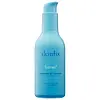What's inside
What's inside
 Key Ingredients
Key Ingredients

 Benefits
Benefits

 Concerns
Concerns

 Ingredients Side-by-side
Ingredients Side-by-side

Water
Skin ConditioningSodium Methyl Cocoyl Taurate
CleansingCocamidopropyl Hydroxysultaine
CleansingGlycerin
HumectantCaprylyl/Capryl Glucoside
CleansingSodium Cocoyl Isethionate
CleansingGlycol Distearate
EmollientBetaine
HumectantPanthenol
Skin ConditioningChondrus Crispus Extract
Skin ConditioningAloe Barbadensis Leaf Juice
Skin ConditioningGluconolactone
Skin ConditioningSodium Hyaluronate
HumectantJojoba Oil/Macadamia Seed Oil Esters
Skin ConditioningSqualene
EmollientPhytosteryl Macadamiate
Skin ConditioningPhytosterols
Skin ConditioningTocopherol
AntioxidantPropanediol
SolventHydroxypropyl Guar Hydroxypropyltrimonium Chloride
Xanthan Gum
EmulsifyingPolyacrylate Crosspolymer-6
Emulsion StabilisingSodium Chloride
MaskingEthylhexylglycerin
Skin ConditioningCitric Acid
BufferingBenzoic Acid
MaskingPhenethyl Alcohol
MaskingPentylene Glycol
Skin ConditioningTrisodium Ethylenediamine Disuccinate
T-Butyl Alcohol
PerfumingSodium Hydroxide
BufferingSodium Benzoate
MaskingPhenoxyethanol
PreservativeWater, Sodium Methyl Cocoyl Taurate, Cocamidopropyl Hydroxysultaine, Glycerin, Caprylyl/Capryl Glucoside, Sodium Cocoyl Isethionate, Glycol Distearate, Betaine, Panthenol, Chondrus Crispus Extract, Aloe Barbadensis Leaf Juice, Gluconolactone, Sodium Hyaluronate, Jojoba Oil/Macadamia Seed Oil Esters, Squalene, Phytosteryl Macadamiate, Phytosterols, Tocopherol, Propanediol, Hydroxypropyl Guar Hydroxypropyltrimonium Chloride, Xanthan Gum, Polyacrylate Crosspolymer-6, Sodium Chloride, Ethylhexylglycerin, Citric Acid, Benzoic Acid, Phenethyl Alcohol, Pentylene Glycol, Trisodium Ethylenediamine Disuccinate, T-Butyl Alcohol, Sodium Hydroxide, Sodium Benzoate, Phenoxyethanol
Honey
HumectantRoyal Jelly Extract
Skin ConditioningCeramide NP
Skin ConditioningVitis Vinifera Seed Oil
EmollientSaponaria Officinalis Leaf Extract
AntimicrobialQuillaja Saponaria Bark Extract
CleansingSapindus Mukorossi Fruit Extract
Skin ConditioningOlea Europaea Leaf Extract
PerfumingOenothera Biennis Oil
EmollientLactobacillus/Soybean Ferment Extract
Skin ConditioningPortulaca Oleracea Extract
Skin ConditioningCinnamomum Cassia Bark Extract
MaskingScutellaria Baicalensis Root Extract
AstringentOriganum Vulgare Leaf Extract
Skin ConditioningChamaecyparis Obtusa Leaf Extract
Skin ConditioningSalix Alba Bark Extract
AstringentGlycolipids
Skin ConditioningPhytosphingosine
Skin ConditioningSodium Cocoyl Glycinate
CleansingSodium Cocoyl Apple Amino Acids
Skin ConditioningPotassium Cocoyl Hydrolyzed Oat Protein
Skin ConditioningBabassuamidopropyl Betaine
CleansingCoco-Glucoside
CleansingPotassium Stearate
CleansingPotassium Myristate
EmulsifyingTromethamine
BufferingSodium Surfactin
CleansingGlyceryl Laurate
EmollientHydrogenated Lecithin
EmulsifyingErythritol
HumectantCaprylic/Capric Triglyceride
MaskingButylene Glycol
HumectantDipropylene Glycol
HumectantC12-15 Alkyl Benzoate
AntimicrobialCaprylyl Glycol
EmollientHexylene Glycol
EmulsifyingEthylhexylglycerin
Skin ConditioningGlyceryl Caprylate
EmollientSodium Benzoate
MaskingPentylene Glycol
Skin ConditioningCI 17200
Cosmetic ColorantCI 19140
Cosmetic ColorantTetrasodium Glutamate Diacetate
Disodium EDTA
Parfum
MaskingHoney, Royal Jelly Extract, Ceramide NP, Vitis Vinifera Seed Oil, Saponaria Officinalis Leaf Extract, Quillaja Saponaria Bark Extract, Sapindus Mukorossi Fruit Extract, Olea Europaea Leaf Extract, Oenothera Biennis Oil, Lactobacillus/Soybean Ferment Extract, Portulaca Oleracea Extract, Cinnamomum Cassia Bark Extract, Scutellaria Baicalensis Root Extract, Origanum Vulgare Leaf Extract, Chamaecyparis Obtusa Leaf Extract, Salix Alba Bark Extract, Glycolipids, Phytosphingosine, Sodium Cocoyl Glycinate, Sodium Cocoyl Apple Amino Acids, Potassium Cocoyl Hydrolyzed Oat Protein, Babassuamidopropyl Betaine, Coco-Glucoside, Potassium Stearate, Potassium Myristate, Tromethamine, Sodium Surfactin, Glyceryl Laurate, Hydrogenated Lecithin, Erythritol, Caprylic/Capric Triglyceride, Butylene Glycol, Dipropylene Glycol, C12-15 Alkyl Benzoate, Caprylyl Glycol, Hexylene Glycol, Ethylhexylglycerin, Glyceryl Caprylate, Sodium Benzoate, Pentylene Glycol, CI 17200, CI 19140, Tetrasodium Glutamate Diacetate, Disodium EDTA, Parfum
 Reviews
Reviews

Ingredients Explained
These ingredients are found in both products.
Ingredients higher up in an ingredient list are typically present in a larger amount.
Ethylhexylglycerin (we can't pronounce this either) is commonly used as a preservative and skin softener. It is derived from glyceryl.
You might see Ethylhexylglycerin often paired with other preservatives such as phenoxyethanol. Ethylhexylglycerin has been found to increase the effectiveness of these other preservatives.
Pentylene glycol is typically used within a product to thicken it. It also adds a smooth, soft, and moisturizing feel to the product. It is naturally found in plants such as sugar beets.
The hydrophilic trait of Pentylene Glycol makes it a humectant. As a humectant, Pentylene Glycol helps draw moisture from the air to your skin. This can help keep your skin hydrated.
This property also makes Pentylene Glycol a great texture enhancer. It can also help thicken or stabilize a product.
Pentylene Glycol also acts as a mild preservative and helps to keep a product microbe-free.
Some people may experience mild eye and skin irritation from Pentylene Glycol. We always recommend speaking with a professional about using this ingredient in your routine.
Pentylene Glycol has a low molecular weight and is part of the 1,2-glycol family.
Learn more about Pentylene GlycolSodium Benzoate is a preservative. It's used in both cosmetic and food products to inhibit the growth of mold and bacteria. It is typically produced synthetically.
Both the US FDA and EU Health Committee have approved the use of sodium benzoate. In the US, levels of 0.1% (of the total product) are allowed.
Sodium benzoate works as a preservative by inhibiting the growth of bacteria inside of cells. It prevents the cell from fermenting a type of sugar using an enzyme called phosphofructokinase.
It is the salt of benzoic acid. Foods containing sodium benzoate include soda, salad dressings, condiments, fruit juices, wines, and snack foods.
Studies for using ascorbic acid and sodium benzoate in cosmetics are lacking, especially in skincare routines with multiple steps.
We always recommend speaking with a professional, such as a dermatologist, if you have any concerns.
Learn more about Sodium Benzoate